Holograms: From Credit Cards to Chocolate
August 5, 2014
There is no thin film, no magic tricks, no additives in the picture seen below — just yummy chocolate injected into a specially made mold that transfers a special topographical structure onto the chocolate’s surface. When light strikes the chocolate’s surface, it produces a beautiful, colorful, hologram.
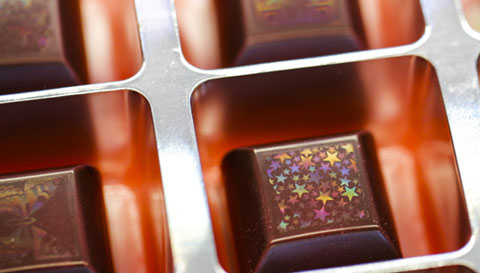
Holograms created with chocolate, light, and ingenuity! No additives.
Image Credit: Morphotonix
Hologram How To
To see anything, light from the object being viewed must enter the eye. To capture the image of anything, light from the object must interact with a light-sensitive material. This is true of regular film photography, digital photography, and holography.
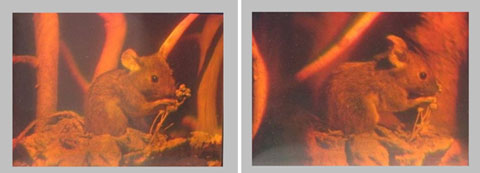
Two photos of a hologram taken at different angles.
Image Credit: Georg-Johann Lay/Epzcaw via Wikimedia Commons
Holography is different than regular photography because a photograph only contains information about the intensity of light coming from the object that reaches the film. Holograms, however, contain information of the intensity and the phase of the light from the object that reaches the film.
Light can be thought of as packets of electromagnetic energy called photons, and as an electromagnetic wave. The phase of the light has to do with where the electromagnetic wave is in its wave cycle. When the wave reaches the film it could be at the top (crest) of the wave, the bottom (trough), or somewhere between the two.
If you take two identical electromagnetic waves and add them, the resultant wave depends on the relative phase between the two waves. The image below shows the result of adding two waves with the same frequency and amplitude.
The waves can combine such that they have complete constructive interference, yielding a wave with twice the amplitude, or they can destructively interfere in a complete way, producing a wave with zero amplitude.

Constructive (left) and destructive (right) interference.
To create a hologram, it is important that all of the light has the same frequency and phase to start. Lasers are the easiest way to produce this type of light.
This coherent laser light (all of the same frequency and in phase) needs to be split in two, such that one part of it reaches the film directly without interacting with the object and the other part of it interacts with the object before reaching the film. When the two beams interact on the film, they will not have traveled the same path lengths and this introduces a phase difference between the beams.
There are a number of ways to split the beam in two. One common way is to use a beamsplitter (for example a partially silvered mirror).
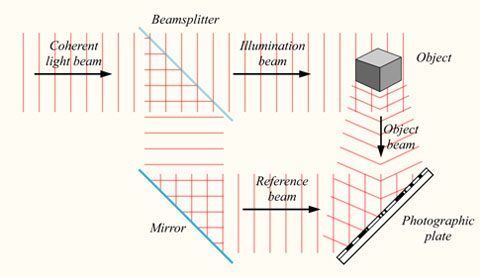
Diagram of one possible set-up for creating a hologram.
Image Credit: Bob Mellish via Wikimedia Commons
This information is stored by mixing the light from the object with the reference light at the film. Today, lasers are the easiest way to produce coherent light, but this often produces a hologram in just one color (the color of the laser light used).
To obtain what the object looks like under white light, the hologram is often made using three or more lasers that contain the primary colors: red, green, and blue. When equal proportions of these colors all enter the common human eye, they are mixed together and appear white.
Mixing different proportions of each color produces all the other colors. You can try this out yourself with the following PhET simulator. This is how TV screens, computer screens, digital cameras, and printers create all their colors.
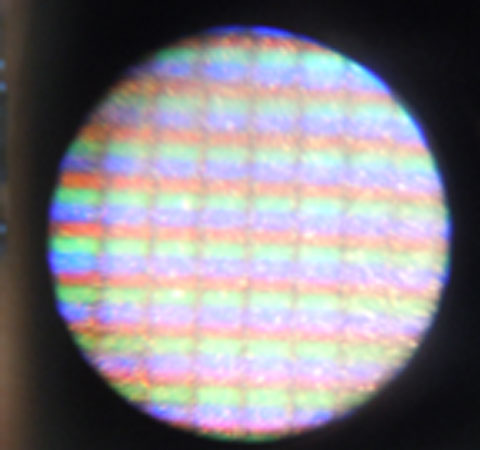
A photograph of TV snow through a hand-held microscope on a flat screen HD TV.
The common rainbow holograms seen on the back of credit cards, on driver’s licenses, and on the Morphotonix chocolates, are often created by placing a thin slit in the beam’s path before it reaches the object. This causes the resulting hologram to be seen as if viewed from a narrow slit. A narrow slit causes different frequencies of light to constructively interfere at different angles, giving a rainbow effect.
The set-up for a hologram can look different than the set-up shown above. For some holograms, they use an in-line set-up where all the components are placed along a single line.
First the laser, then a diverging lens that spreads out the laser beam, then a thick emulsion material (the film) with a glass plate on each side, and finally the object. Light coming from the front side of the film interferes with light headed back from the object, and this contains the phase and intensity information needed.
Seeing Holograms
One of the very cool features about holograms is that the entire film exposure contains information from the object. For example, if you cut a photograph in half, you can only see half of the object that was photographed. This is because each point in a regular photograph only contains intensity information.
For a hologram, each point contains the entire light field (phase information and intensity information) from every point of the object that reflects light to that point on the film. And, this occurs for many viewing angles. In this way, each part of the film contains information from the entire object.
For example, if you cut a hologram in half, you can still see the entire image of the object, but now you only have some of the viewing angles. It is like looking through a window, and then covering up half of the window with a thick curtain.
From different angles looking through the “half” window, you can still see all the same objects as before; only some of the viewing angles are now blocked by the curtain, but the entire object is still visible from a different angle of viewing.
If you were to look at the exposed emulsion (film), you would see the effects of an interference pattern between the reference beam and the beam from the object. Below is a photograph of a holographic recording that shows the interference pattern.
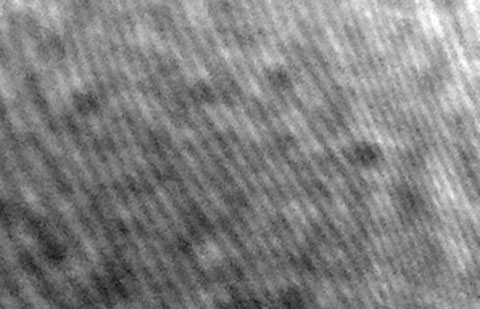
The encoded information (an interference pattern), of a transmission hologram on photographic emulsion.
Image Credit: Epzcaw via Wikimedia Commons
The hologram created can be a transmission or reflection hologram. For a transmission hologram you view the same coherent light transmitted through the exposed film.
For a reflected hologram you view coherent light reflected off the film or an embossment of the film. Below is a diagram of how to reconstruct an image of the object from the holographic film.
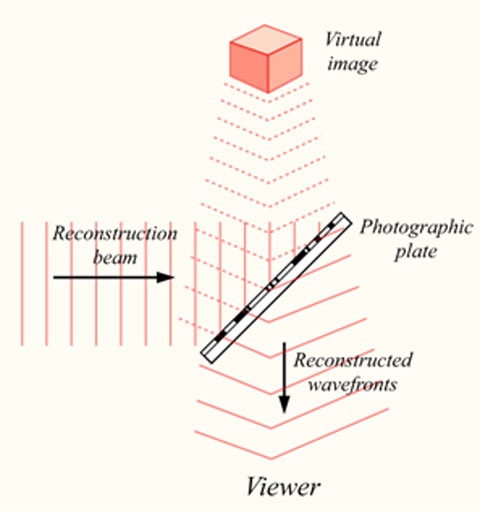
Diagram of how to reconstruct the image of the object from the exposed film. The viewer sees a reconstructed image from the coherent light source interacting with the previously exposed photographic plate that contains information about the object.
Image Credit: Bob Mellish via Wikimedia Commons
Holographic Film
What is this film and how does it store the information about the object? Basically it is the same as photographic film, except often a thicker emulsion is used and it is attached to glass or plastic. The emulsion (regular film and holographic film) is made of a mixture of gelatin and silver halide crystals (e.g. silver bromide and silver chloride).
When light strikes the silver halide crystals in the gelatin, it gets absorbed by the outermost electrons. This causes a valence electron (outermost electron) to go up to a higher allowed energy level, which happens to be in the conduction band (almost removed from the atom).
Silver ions, within the silver halide crystal, can then capture this electron, causing microscopic congregations of four or more silver atoms to form in the silver halide crystals. The areas where these silver atoms congregate cause a change in the film’s surface.
A thin hologram is one in which the thickness of the emulsion is much less than the spacing between the interference fringes produces.
When a thick emulsion is used - one whose thickness is much greater than the spacing of the interference pattern created by the reference beam mixing with the beam from the object - it is called a volume hologram. This type of hologram has a three dimensional structure due to the change in the emulsion from the silver atoms congregating.
In this case, many different frequencies of incident light are diffracted from this 3-dimensional structure, which acts like a grating. This reproduces the hologram in a variety of colors when viewed under white light — creating a rainbow or white light hologram.
And this leads us back to the how they make those great reflective holograms on the back of credit cards and on your driver’s license.
For the thick emulsion, the information for the hologram is embedded within the surface features of the emulsion. All the surface structures (where atoms have clumped together and collapsed) form a 3-dimensional structure that can be coated in metal to make an embossing tool.
This metal embosser can be used to stamp (or emboss) the topographic pattern into another material such as thin piece of metal foil, which is then coated with a thin piece of plastic. When white light strikes the plastic over embossed foil, it goes through the plastic and reflects off the foil, and is affected in the same way as viewing the hologram in the emulsion. The different colors depend on the angle of viewing.
Lithography and Holography
Making a metal lithograph of a hologram involves micro and/or nano-patterning a master mold that can also be used as an embosser. For many security holograms, special care is taken to ensure they are not easily reproduced.
This often requires making an embosser using state of the art equipment, such as electron lithography. The metal lithograph stamps and/or master molds replicate the pattern of a hologram on plastic films, or, more recently, replicates it into rigid plastic articles directly.
Making a customized holographic tool of any shape for replication in rigid plastic is one of the specialties of Morphotonix, the company that makes the holographic chocolates.
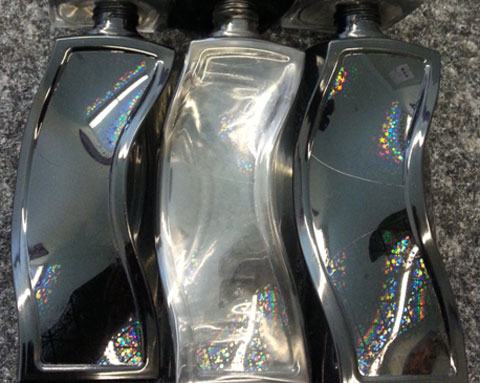
Plastic bottles with holograms replicated on the bottles surface.
Image Credit: Morphotonix
Molds, Chocolates, and Beyond
For the holographic chocolates, it is important to create a plastic mold with the inverse pattern of the hologram to be produced. When melted chocolate is poured into the plastic mold, the pattern of the hologram is replicated on the surface of the chocolate.
One of the important requirements for creating a reflective hologram with chocolate (or any surface) is that it must be constructed of molecules that can maintain the surface structure of the hologram. If the molecules are too big, or slip to re-orient themselves, the fine structure of the surface, which is not visible to the naked eye, will not diffract the light in the way needed to reconstruct the image.
Veronica Savu and Vaida Auzelyte, the founders of Morphotonix, aim to not only make eye-captivating chocolates but also take the technology in new directions. On their webpage they list uses such as holographic trademarks embedded directly in rigid plastics.
And what really sets this apart from all the rest is best described in Savu’s own words, “The micro/nano-structures from the tool surface are replicated into the plastic via injection molding, and the product has an embedded hologram that cannot be peeled off (it is not a label), it does not require any additives (the holographic effects are due to the controlled roughness of the plastic at the micrometer-scale), and is there since the production of the article (the effect is visible as soon as the plastic is fabricated).”
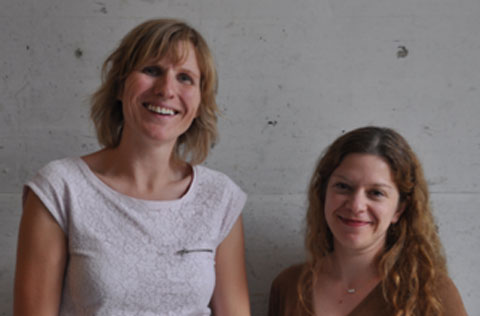
Veronica Savu and Vaida Auzelyte are co-founders of Morphotonix.
Image Credit: Morphotonix
References and Resources
1. Morphontonix websitehttp://www.morphotonix.com/
2. Pandkia, M., Taking Chocolate to the Next Level, OZY, 10 June 2014
http://www.ozy.com/good-sht/feast-your-eyes-on-morphotonixs-chocolate-holograms/31907.article
3. Balen, B., Chocolate with Holographic Images New from Switzerland, Guardian, 19 May 2014
http://guardianlv.com/2014/05/chocolate-with-holographic-images-new-from-switzerland/
4. Holography, Wikipedia
http://en.wikipedia.org/wiki/Holography
5. Silver halide, Wikipedia
http://en.wikipedia.org/wiki/Silver_halide
6. Wilson, T.V. How Holograms Work, How Stuff Works
http://science.howstuffworks.com/hologram10.htm
7. Halliday, D., Resnick, R., and Walker, J., Fundametals of Physics, John Wiley & Sons, New York (1993).
8. Hecht, E. and Zajac, A., Optics Addison-Wesley, CA, (1976)
—H.M. Doss














